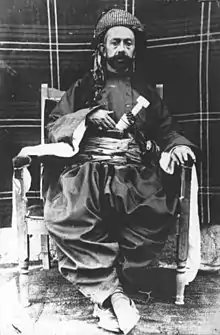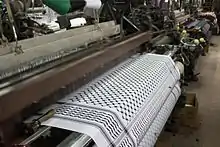Keffiyeh
The keffiyeh or kufiya (Arabic: كُوفِيَّة, romanized: kūfīyah, lit. 'relating to Kufa'),[1] also known in Arabic as a ghutrah (غُترَة), shemagh (شُمَاغ šumāġ), ḥaṭṭah (حَطَّة) and, in Persian, as a čafiya (چفیه) or čapiya (چپیه), is a traditional headdress worn by men.
.jpg.webp)

It is fashioned from a square scarf, and is usually made of cotton.[2] The keffiyeh is commonly found in arid regions, as it provides protection from sunburn, dust and sand. An agal is often used to keep it in place.
Varieties and variations

Other than Arabs, Kurds are another ethnic group famous for wearing a headpiece similar to the keffiyeh but different as it is wrapped completely different and has a different pattern or colorway than the Arab one. Kurds either call it a Shemagh (Kurdish: شهماغ) or Serwîn (Kurdish: سهروین).[3]
During his sojourn with the Marsh Arabs of Iraq, Gavin Young noted that the local sayyids—"venerated men accepted [...] as descendants of the Prophet Muhammad and Ali ibn Abi Talib"—wore dark green keffiyeh (cheffiyeh) in contrast to the black-and-white checkered examples typical of the area's inhabitants.[4]
In Indonesia, some of the people used the keffiyeh to show their solidarity with the Palestinians.[5]
In Turkey, it was forbidden to wear a keffiyeh because it was seen as evidence of support of the PKK, a Kurdish rebel group.[6]
Palestinian national symbol
.jpg.webp)
Traditionally worn by Palestinian farmers, the keffiyeh became worn by Palestinian men of any rank and became a symbol of Palestinian nationalism during the Arab Revolt of the 1930s.[7][8] Its prominence increased during the 1960s with the beginning of the Palestinian resistance movement and its adoption by Palestinian leader Yasser Arafat.[7]
The black-and-white fishnet pattern keffiyeh would later become Arafat's iconic symbol, and he would rarely be seen without it; only occasionally would he wear a military cap, or, in colder climates, a Russian-style ushanka hat. Arafat would wear his keffiyeh in a semi-traditional way, wrapped around his head via an agal. He also wore a similarly patterned piece of cloth in the neckline of his military fatigues. Early on, he had made it his personal trademark to drape the scarf over his right shoulder only, arranging it in the rough shape of a triangle, to resemble the outlines of historic Palestine. This way of wearing the keffiyeh became a symbol of Arafat as a person and political leader, and it has not been imitated by other Palestinian leaders.
Another Palestinian figure associated with the keffiyeh is Leila Khaled, a female member of the armed wing of the Popular Front for the Liberation of Palestine. Several photographs of Khaled circulated in the Western newspapers after the hijacking of TWA Flight 840 and the Dawson's Field hijackings. These photos often included Khaled wearing a keffiyeh in the style of a Muslim woman's hijab, wrapped around the head and shoulders. This was unusual, as the keffiyeh is associated with Arab masculinity, and many believe this to be something of a fashion statement by Khaled, denoting her equality with men in the Palestinian armed struggle.
The colors of the stitching in a keffiyeh are also vaguely associated with Palestinians' political sympathies. Traditional black and white keffiyehs became associated with Fatah. Later, red and white keffiyehs were adopted by Palestinian Marxists, such as the PFLP.[9]
Symbol of Palestinian solidarity

The black and white chequered keffiyeh has become a symbol of Palestinian nationalism, dating back to the 1936–1939 Arab revolt in Palestine. Outside of the Middle East and North Africa, the keffiyeh first gained popularity among activists supporting the Palestinians in the conflict with Israel.
The wearing of the keffiyeh often comes with criticism from various political factions in the ongoing Israeli–Palestinian conflict. The slang "keffiyeh kinderlach" refers to young Jews, particularly college students, who sport a keffiyeh around the neck as a political/fashion statement. This term may have first appeared in print in an article by Bradley Burston in which he writes of "the suburban-exile keffiyeh kinderlach of Berkeley, more Palestinian by far than the Palestinians" in their criticism of Israel. European activists have also worn the keffiyeh.[10][11]
Production
.jpg.webp)
Today, this symbol of Palestinian identity is now largely imported from China. With the scarf's growing popularity in the 2000s, Chinese manufacturers entered the market, driving Palestinians out of the business.[12] In 2008, Yasser Hirbawi, who for five decades had been the only Palestinian manufacturer of keffiyehs, is now struggling with sales.
Mother Jones wrote, "Ironically, global support for Palestinian-statehood-as-fashion-accessory has put yet another nail in the coffin of the Occupied Territories' beleaguered economy."[12]
Westerners in keffiyeh

British Colonel T. E. Lawrence (better known as Lawrence of Arabia) was probably the best-known Western wearer of the keffiyeh and agal during his involvement in the Arab Revolt in World War I. This image of Lawrence was later popularized by the film epic about him, Lawrence of Arabia, in which he was played by Peter O'Toole.
The 1920s silent-film era of American cinema saw studios take to Orientalist themes of the exotic Middle East, possibly due to the view of Arabs as part of the Allies of World War I, and keffiyehs became a standard part of the theatrical wardrobe. These films and their male leads typically had Western actors in the role of an Arab, often wearing the keffiyeh with the agal (as with The Sheik and The Son of the Sheik, starring actor Rudolph Valentino).
Fashion trend
As with other articles of clothing worn in wartime, such as the T-shirt, fatigues and khaki pants, the keffiyeh has been seen as chic among non-Arabs in the West. Keffiyehs became popular in the United States in the late 1980s, at the start of the First Intifada, when bohemian girls and punks wore keffiyehs as scarves around their necks.[13][7] In the early 2000s, keffiyehs were very popular among youths in Tokyo, who often wore them with camouflage clothing.[13] The trend recurred in the mid-2000s in the United States,[13][7] Europe,[7] Canada and Australia,[14][15] when the keffiyeh became popular as a fashion accessory, usually worn as a scarf around the neck in hipster circles.[13][7] Stores such as Urban Outfitters and TopShop stocked the item (however, after some controversy over the retailer's decision to label the item "anti-war scarves" Urban Outfitters pulled it).[7] In spring 2008, keffiyehs in colors like purple and mauve were given away in issues of fashion magazines in Spain and France. In the UAE, males are inclining towards more western headgear while the women are developing preferences for dupatta—the traditional head cover of South Asia.[16] The appropriation of the keffiyeh as a fashion statement by non-Arab wearers separate from its political and historical meaning has been the subject of controversy in recent years.[17] While it is worn often as a symbol of solidarity with the Palestinian struggle, the fashion industry has disregarded its significance by using its pattern and style in day-to-day clothing design. For example, in 2016 Topshop released a romper with the Keffiyeh print, calling it a "scarf playsuit". This led to accusations of cultural appropriation and Topshop eventually pulled the item from their website.[18]
See also
- Agal, Keffiyeh accessory
- Emamah, Arabian turban
- Litham, Arabian headdress
- Turban, headdress worn in Central and Western Asia.
- Tagelmust, Berber scarf
- Tallit, Jewish shawl
- Sudra, Jewish scarf
- List of headgear
- Gamcha, scarf from South Asia
- Khăn rằn, checkered shawl worn in Cambodia and Vietnam
- Krama, Cambodian scarf
References
- Ali, Syed Ameer (1924). A Short History of the Saracens. Routledge. pp. 424–. ISBN 978-1-136-19894-6.
Kufa was famous for its silk and half-silk kerchiefs for the head, which are still used in Western Asia and known as Kuffiyeh.
- J. R. Bartlett (19 July 1973). The First and Second Books of the Maccabees. CUP Archive. p. 246. ISBN 978-0-521-09749-9. Retrieved 17 April 2013.
traditional Jewish head-dress was either something like the Arab's Keffiyeh (a cotton square folded and wound around a head) or like a turban or stocking cap
- "Learn About Kurdish Dress".
- Young, Gavin (1978) [First published by William Collins & Sons in 1977]. Return to the Marshes. Photography by Nik Wheeler. Great Britain: Futura Publications. pp. 15–16. ISBN 0-7088-1354-2.
There was a difference here for nearly all of them wore dark green kefiyahs (or cheffiyeh) (headcloths) instead of the customary black and white check ones. By that sign we could tell that they were sayyids, like the sallow-faced man at Falih's.
- Times, Asia (20 December 2017). "Asia Times | Indonesia shows its solidarity for the Palestinian cause | Article". Asia Times. Retrieved 21 September 2019.
- Uche, Onyebadi (14 February 2017). Music as a Platform for Political Communication. IGI Global. p. 214. ISBN 9781522519874.
- Kim, Kibum (11 February 2007). "Where Some See Fashion, Others See Politics". The New York Times. New York, New York.
- Torstrick, Rebecca (2004). Culture and Customs of Israel. Greenwood. p. 117. ISBN 978-0-313-32091-0.
- Binur, Yoram (1990). My Enemy, My Self. Penguin. p. xv.
- Tipton, Frank B. (2003). A History of Modern Germany Since 1815. Continuum International Publishing Group. p. 598. ISBN 0-8264-4910-7.
- Mudde, Cas (2005). Racist Extremism in Central and Eastern Europe. Routledge. p. 34. ISBN 0-415-35594-X.
- Sonja Sharp (22 June 2009). "Your Intifada: Now Made in China!". Mother Jones.
- Lalli, Nina (15 February 2005). "Checkered Past: Arafat's trademark scarf is now military chic". The Village Voice. New York, New York. Archived from the original on 24 July 2008.
- Ramachandran, Arjun (30 May 2008). "Keffiyeh kerfuffle hits Bondi bottleshop". The Sydney Morning Herald. Sydney, New South Wales, Australia. Archived from the original on 29 August 2011. Retrieved 24 September 2013.
- Ramachandran, Arjun (29 May 2008). "Celebrity chef under fire for 'jihadi chic'". The Sydney Morning Herald. Sydney, New South Wales, Australia. Archived from the original on 21 September 2011. Retrieved 24 September 2013.
- "What do Arabs wear on their heads". UAE Style Magazine. 24 August 2013.
- Swedenburg, Ted (2021). "The Kufiya". In Bayat, Asef (ed.). Global Middle East: Into the Twenty-First Century. Berkeley, California: University of California Press. pp. 162–173. ISBN 978-0-520-96812-7. Retrieved 13 May 2021.
- "Topshop pulls 'keffiyeh playsuit' after row over cultural theft". middleeasteye.net. Retrieved 1 September 2017.
Further reading
- Philippi, Dieter (2009). Sammlung Philippi – Kopfbedeckungen in Glaube, Religion und Spiritualität. St. Benno Verlag, Leipzig. ISBN 978-3-7462-2800-6.
- Jastrow, Marcus (1926). Dictionary of Targumim, Talmud and Midrashic Literature. ISBN 978-1-56563-860-0. The lexicon includes more references explaining what a sudra is on page 962.
External links
- "The Keffiyeh and the Arab Heartland" from About.com
- "Saudi Aramco World: The dye that binds" by Caroline Stone
- More references about a sudra on page 962 from Jastrow Dictionary Online
- Modern Chronology of the Keffiyah Kraze from Arab American blog Kabobfest
- Che Couture Gives way to Kurds' Puşi Chic by Işıl Eğrikavuk, Hurriyet
- Palestinian Keffiyeh outgrows Mideast conflict
- Last factory in Palestine produces Kuffiyeh
- Hirbawi: The Only Original Kufiya Made in Palestine
.jpg.webp)